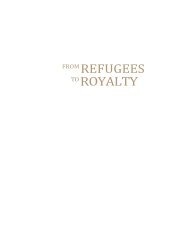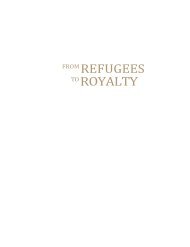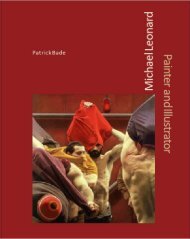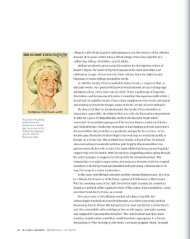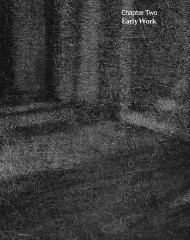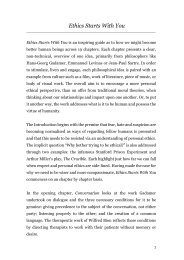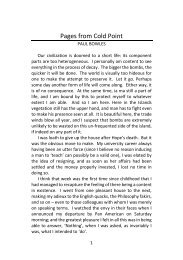Ethics Starts With You Outline
An in depth overview of the material covered in our new book by Dr Jim Walsh, Ethics Starts With You.
An in depth overview of the material covered in our new book by Dr Jim Walsh, Ethics Starts With You.
- No tags were found...
You also want an ePaper? Increase the reach of your titles
YUMPU automatically turns print PDFs into web optimized ePapers that Google loves.
ETHICS STARTS WITH YOU<br />
<strong>Outline</strong><br />
<strong>Ethics</strong> <strong>Starts</strong> <strong>With</strong> <strong>You</strong> is an inspiring guide to how we might become better human<br />
beings. The three-part book contains 26 discussions, each presenting a clear<br />
overview of one philosophical idea from renowned figures including Hans-Georg<br />
Gadamer, Emmanuel Levinas and Jean-Paul Sartre. Each of these ideas is paired<br />
with a cultural object, such as a film, work of literature, piece of music, or artwork.<br />
The overall aim of this book is to encourage a more personal ethical and moral point<br />
of view, and prompt thoughts about our relationships with other people and what<br />
effect our behaviour has on them. <strong>Ethics</strong> <strong>Starts</strong> <strong>With</strong> <strong>You</strong> explores what it means to<br />
be human, not biologically, but in the sense of our moral and ethical virtues.<br />
The first part of the book begins with introductory chapters about ethics and respect.<br />
In <strong>Ethics</strong>, the premise that fear, hate and suspicion are becoming normal ways of<br />
regarding fellow humans is presented, and that this needs to be stopped by an<br />
understanding of personal ethics. In Respect, the question “Why bother trying to be<br />
ethical?” is addressed through two examples: the infamous Stanford Prison<br />
Experiment and Arthur Miller’s play, The Crucible. Each highlight just how far we<br />
can fall when we lose our respect and personal ethics. Having made the case for why<br />
we need to be wiser and more compassionate in the introduction, <strong>Ethics</strong> <strong>Starts</strong> <strong>With</strong><br />
<strong>You</strong> now commences.<br />
In the first discussion, called Prejudices, Gadamer is introduced with the first of his<br />
philosophical ideas: understanding how one’s prejudices can lead to a moral outlook<br />
towards others. Sherlock Holmes’ prejudices towards women in A Scandal in<br />
Bohemia by Arthur Conan Doyle are exposed and given as an example, whilst Irene<br />
Adler exemplifies how one can go beyond those who would seek to define us.<br />
In the next discussion, Horizons, Gadamer’s thoughts on personal horizons are<br />
considered, giving priority to the theme of understanding. For Gadamer, when a<br />
fusion of horizons between two individuals occurs, understanding follows. Irvin<br />
Yalom’s novel, The Schopenhauer Cure, works through just such a fusing of horizons<br />
as the two main protagonists seek to understand and learn from each other.<br />
Conversation breaks down Gadamer’s three conditions for speech and dialogue to be<br />
genuine: giving precedence to the subject or topic of the conversation, not either<br />
party; listening properly to the other person; and the creation of a common language.<br />
The therapeutic work of Wilfred Bion reflects these conditions by directing therapists<br />
to work with their patients without memory or desire.<br />
In Experience Gadamer critiques Immanuel Kant’s views on aesthetics and develops<br />
his own ideas on what experiencing art do for the spectator. The works of Francis<br />
Bacon and René Magritte are explored here, and help explain Gadamer’s idea that art<br />
“has its true being in the fact it becomes an experience that changes the person who<br />
experiences it.”<br />
ETHICS STARTS WITH YOU, Dr Jim Walsh – <strong>Outline</strong> 1
In Play, Gadamer describes different forms of experience as either ‘something you<br />
have’ or ‘something you experience.’ Play is identified as something you experience<br />
or participate in. Benny Goodman’s 1938 Jazz concert at Carnegie Hall provides an<br />
understanding of play from multiple perspectives: the musicians’, the audiences’, and<br />
our own, as listeners not at the concert.<br />
Art follows Gadamer as he focuses on visuals and aesthetics through works of art.<br />
The viewpoint taken is one where the artwork offers a “timeless present”. He looks at<br />
how the artwork is constant and always personal to person looking at it, and states<br />
that artworks say “something to each person as if it were said especially to him.”<br />
Mozart’s overture to The Marriage of Figaro is given as the cultural example of this.<br />
In the next discourse, Understanding, Gadamer realises how an “anticipation of<br />
meaning” steers one’s thinking and presents obstacles when engaging with the other,<br />
whether that is a person or a work of art. Instead, we need to seek an open mind.<br />
Sartre’s play, No Exit, provides a negative example to such openness, due to the three<br />
characters being so strictly closed in their thinking.<br />
The final essay in this part, Commitment, looks at Gadamer’s work on the claim an<br />
artwork holds upon its spectator, and the reciprocity of a relationship between<br />
artwork and individual. When thinking about music, and considering Stanley Cavell’s<br />
work on the subject, Gadamer realises that sometimes there is a requirement for<br />
listening with an ethical ear as opposed to a musical one. Trust rather than aesthetics<br />
comes into play. The music of AC/DC is given as an example of how one can commit<br />
to an artform and how one might benefit from that commitment.<br />
The second part of the book has eight essays and focuses on the philosophy of<br />
Emmanuel Levinas, with support from Silvia Benso.<br />
Otherness introduces Levinas’ thoughts on the il y a, which is a sense of otherness or<br />
a presence that comes from without. The il y a is Levinas’ catalyst for understanding<br />
the otherness of others. Kafka’s The Burrow, in its exposition of the mole’s<br />
increasing sense that another animal/lifeform is somehow present around his/her<br />
burrow, provides an instance of such otherness.<br />
The Face presents Levinas’ philosophy of the face, as the most basic mode of<br />
responsibility. It is explained how the face is dynamic, it comes from without, it<br />
brings infinite responsibility and has an impact on our ego. The face demands that<br />
we look and see differently. Clyfford Still’s works, by having titles and traditional<br />
content removed, enable the viewer to have the freedom to see things differently.<br />
The desire to understand and to know is examined in The Self. Western rationality,<br />
with its need to understand everything perfectly, is seen by Levinas as a “project of<br />
mastery” that eradicates otherness in favour of promoting the self. Barnett Newman<br />
is held up as an example of self-obsession, with his works projecting so much<br />
‘Barnett Newman’ that there is no space for a sense of otherness at all.<br />
Eyes examines the ‘social’ relationship identified by Levinas when two people engage<br />
in genuine dialogue and have eye contact. The priority of the self, for both, gives way<br />
to the sincerity and respect of their conversation. As we allow the otherness of the<br />
Other person to be present, our humanity unveils itself. The primacy of focusing on<br />
ETHICS STARTS WITH YOU, Dr Jim Walsh – <strong>Outline</strong> 2
difference when looking at people or objects is critiqued through investigation of<br />
Clyfford Still’s work, which unifies space and figure to both unsettle and liberate the<br />
spectator.<br />
Two interpretations of art, by the early and later Levinas, are given in The Gaze. The<br />
shadow realm of art in the first reading, is swiftly replaced by the second’s more<br />
sophisticated account where abstract art, in particular, resists being totalised by the<br />
subject. Silvia Benso teaches us about the ethics involved in such encounters.<br />
Jackson Pollock’s work provides example, with his thought that spectators should<br />
not bring “preconceived ideas,” but rather look passively, with open minds.<br />
In Tenderness, Benso’s prior work on the ethics of an encounter, between a thing and<br />
a subject, is taken further with her introduction of touch, attention, and tenderness<br />
as mediums that respectively allow otherness, prioritise humility and give off an<br />
attitude of welcoming. Rothko’s works, by their seemingly explicit request for silence<br />
and sensitivity from spectators, are presented as almost visual reflections or enablers<br />
of Benso’s mediums.<br />
Self-forgetting begins with Gadamer’s thoughts on festivals as events that enable<br />
self-forgetfulness in participants. Benso’s views follow, but with a focus on festivals<br />
as spaces and that can interrupt the everyday, to allow otherness, which leads to<br />
ethics. Ernest Hemmingway’s Fiesta and Joanne Harris’ Chocolat are given as<br />
possible examples of such festival experiences.<br />
In Openness, the question around otherness actually leading to ethics is asked.<br />
Benso’s thoughts on touch, attention, tenderness and festival are shown to come<br />
together in facilitating otherness, which leads directly to ethics. Tolstoy’s novella The<br />
Death of Ivan Ilyich is presented as the antithesis of Benso’s ideas with the main<br />
characters being devoid of ethical behaviour.<br />
The third part of the book has eight chapters and looks mainly at the philosophy of<br />
Jean-Paul Sartre.<br />
Couched as an aesthetic interlude, Spectatorship examines the experience of art<br />
through the eyes of Kandinsky, Susan Sontag and Jennette Winterson. Spectatorship<br />
itself is brought into question and it is explored that artists increasingly have to<br />
resort to extreme measures to capture the attention and concentration of their<br />
spectators. The metaphor of artist as a kidnapper is presented.<br />
In Consciousness, the Sartrean epiphany of “man is condemned to be free” is<br />
balanced with his declaration at the end of Being and Nothingness that he will write<br />
on ethics in a future work. Harry Lime, in The Third Man is given as an example of<br />
someone who grabs at freedom but has no steadying ethical counterweight.<br />
Nothingness examines Sartre’s idea that between us and the world a “buffer of<br />
nothingness” is present at times of choice and/or deliberation, where we display<br />
freedom and our human capacity to go beyond the ordinary or predictable. In<br />
Nausea, Roquentin and Anny portray different manifestations of nothingness,<br />
respectively, nausea and the desire for “perfect moments”.<br />
ETHICS STARTS WITH YOU, Dr Jim Walsh – <strong>Outline</strong> 3
Freedom explores Sartre’s thoughts regarding time. We, as individuals, are not<br />
bound by decisions made in the past, therefore, we can change who we are in the<br />
present. Such freedom, though, can induce anguish. Derek Vinyard, in American<br />
History X, realises his freedom to reinvent himself when he becomes the<br />
archetypical neo-Nazi. Dr Bob Sweeney helps Vinyard view this as a mistake and that<br />
he is also free to reject this path.<br />
In Bad Faith, attention is paid to how anguish can cause bad faith. For Sartre, this<br />
amounts to lying to oneself about oneself, one’s actions and, in extremes, that one<br />
has a purpose given by a supervening force. Jorge of Burgos, in Umberto Eco’s The<br />
Name of the Rose, is presented as someone acting in the extreme version of bad faith<br />
by seeing themselves as the “hand of God”.<br />
In Responsibility, the opposite of bad faith is examined for Sartre, as the fact that we<br />
have freedom demands that we also have responsibility. However, philosophically<br />
this doesn’t necessarily follow and a leap of faith appears to be required. Authenticity<br />
is brought in to try and resolve this. Frank Owen, in Robert Tressell’s The Ragged<br />
Trousered Philanthropists, is seen to demonstrate authenticity and responsibility by<br />
not taking easy options.<br />
The penultimate essay, Ourselves, works through Sartre’s declaration of freedom as a<br />
value and that we, as individuals, should think of ourselves a project. Sartre is also<br />
seen to invent himself, by finally casting-off ontology and embracing his own<br />
philosophy, based on a belief in freedom. Georgia O’Keeffe’s rejection of “doing what<br />
had already been done” meant finding her own path and realising that she had the<br />
freedom to invent herself as an artist.<br />
The final essay, Becoming, reflects upon Nietzsche’s moral perfectionism, through<br />
James Conant’s piercing lens which corrects a mistranslation at the same time as<br />
presenting inherent wisdom. The idea that we should see ourselves as permanently<br />
in a state of becoming, of evolving is drawn out as an example of how to live. John<br />
Lee Hooker is given as a case study of someone who lived his life in this manner.<br />
ETHICS STARTS WITH YOU, Dr Jim Walsh – <strong>Outline</strong> 4



